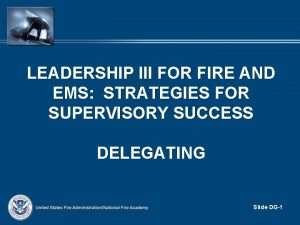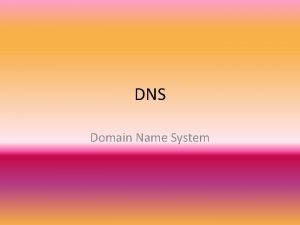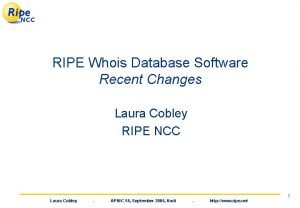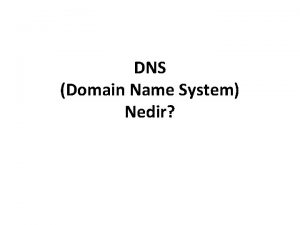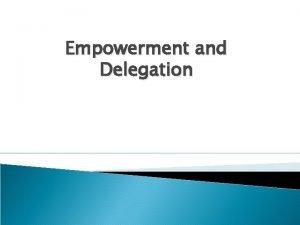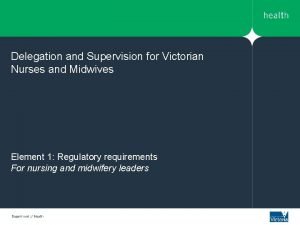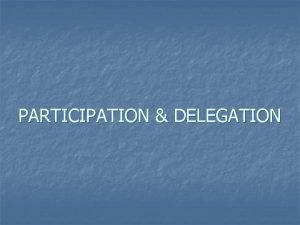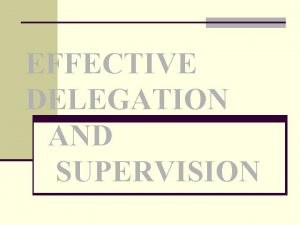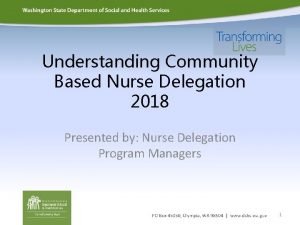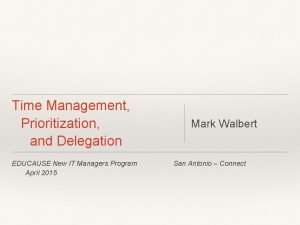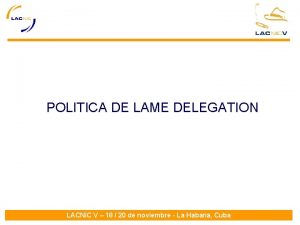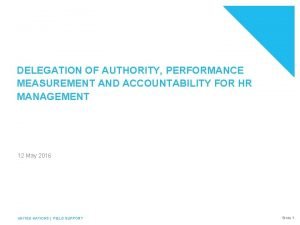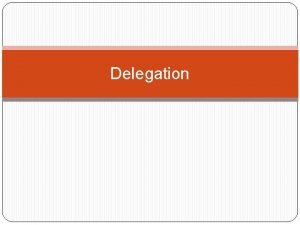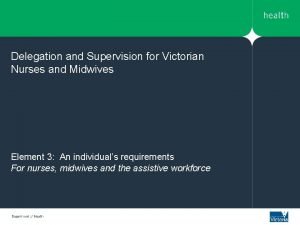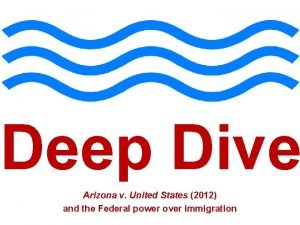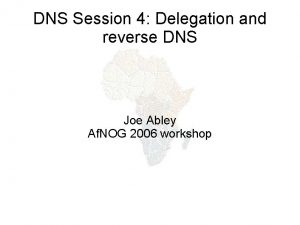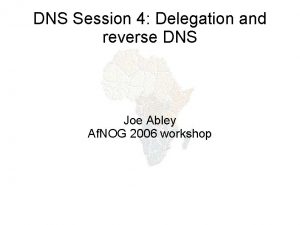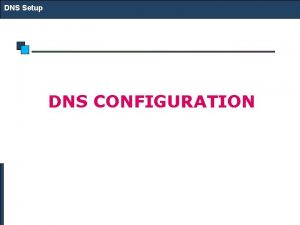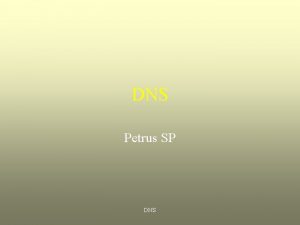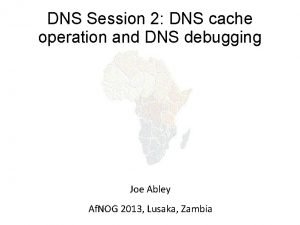DNS Session 4 Delegation and reverse DNS Joe


















- Slides: 18

DNS Session 4: Delegation and reverse DNS Joe Abley Af. NOG 2006 workshop

How do you delegate a subdomain? ● ● In principle straightforward: just insert NS records for the subdomain, pointing at someone else's servers If you are being careful, you should first check that those servers are authoritative for the subdomain – ● by using "dig +norec" on all the servers If the subdomain is managed badly, it reflects badly on you! – and you don't want to be fielding problem reports when the problem is somewhere else

Zone file for "example. com" $TTL 1 d @ 1 h IN IN SOA ns 1. example. net. brian. nsrc. org. ( 2004030300 ; Serial 8 h ; Refresh 1 h ; Retry 4 w ; Expire 1 h ) ; Negative NS NS NS ns 1. example. net. ns 2. example. net. ns 1. othernetwork. com. ; My own zone data IN MX 10 mailhost. example. net. www IN A 212. 74. 112. 80 ; A delegated subdomain subdom IN NS ns 1. othernet. IN NS ns 2. othernet.

There is one problem here: ● ● NS records point to names, not IPs What if zone "example. com" is delegated to "ns. example. com"? Someone who is in the process of resolving (say) www. example. com first has to resolve ns. example. com But in order to resolve ns. example. com they must first resolve ns. example. com !!

In this case you need "glue" ● ● A "glue record" is an A record for the nameserver, held higher in the tree Example: consider the. com nameservers, and a delegation for example. com ; this is the com. zone example NS NS ns. example. com. ns. othernet. ns. example. com. A 192. 0. 2. 1 ; GLUE RECORD

Don't put in glue records except where necessary ● ● In the previous example, "ns. othernet. net" is not a subdomain of "example. com". Therefore no glue is needed. Out-of-date glue records are a big source of problems – e. g. after renumbering a nameserver – Results in intermittent problems, difficult to debug

Example where a glue record IS needed ; My own zone data IN MX www IN A 10 mailhost. example. net. 212. 74. 112. 80 ; A delegated subdomain subdom IN NS ns 1. subdom IN NS ns 2. othernet. ns 1. subdom IN A 192. 0. 2. 4 ; needs glue ; doesn't

Checking for glue records ● ● dig +norec. . . and repeat several times Look for A records in the "Additional" section whose TTL does not count down $ dig +norec @a. gtld-servers. net. www. as 9105. net. a. . . ; ; flags: qr; QUERY: 1, ANSWER: 0, AUTHORITY: 2, ADDITIONAL: 1 ; ; QUERY SECTION: ; ; www. as 9105. net, type = A, class = IN ; ; AUTHORITY SECTION: as 9105. net. 172800 IN IN NS NS ns 0. as 9105. com. ns 0. tiscali. co. uk. ; ; ADDITIONAL SECTION: ns 0. as 9105. com. 172800 IN A 212. 139. 129. 130

Practical ● Delegating a subdomain

Loose ends: how to manage reverse DNS ● If you have at least a /24 of address space then your provider will arrange delegation to your nameservers ● e. g. your netblock is 196. 222. 0. 0/24 ● Set up zone 0. 222. 196. in-addr. arpa. ● ● If you have more than a /24, then each /24 will be a separate zone If you a lucky enough to have a /16 then it will be a single zone – 196. 222. 0. 0/16 is 222. 196. in-addr. arpa.

Example: 196. 222. 0/24 /etc/namedb/named. conf zone “ 0. 222. 196. in-addr. arpa" { type master; file "master/196. 222. 0"; allow-transfer {. . . }; }; /etc/namedb/master/196. 222. 0 @ IN IN IN SOA NS NS . . ns 0. example. com. ns 0. othernetwork. com. 1 IN 2 IN 3 IN 4 IN ; etc PTR PTR router-e 0. example. com. ns 0. example. com. mailhost. example. com. www. example. com.

How it works ● ● ● e. g. for 196. 222. 0. 4, the remote host will lookup 4. 0. 222. 196. in-addr. arpa. (PTR) The query follows the delegation tree as normal. If all is correct, it will reach your nameservers and you will reply Now you can see why the octets are reversed – The owner of a large netblock (e. g. 192/8) can delegate reverse DNS in chunks of /16. The owner of a /16 can delegate chunks of /24

There is nothing special about reverse DNS ● ● ● You still need master and slave(s) It won't work unless you get delegation from above However, DO make sure that if you have a PTR record for an IP address, that the hostname resolves back to the same IP address – Otherwise, many sites on the Internet will think you are spoofing reverse DNS and will refuse to let you connect

What if you have less than /24? ● ● Reverse DNS for the /24 has been delegated to your upstream provider Option 1: ask your provider to insert PTR records into their DNS servers – ● Problem: you have to ask them every time you want to make a change Option 2: follow the procedure in RFC 2317 – Uses a trick with CNAME to redirect PTR requests for your IPs to your nameservers

e. g. you own 192. 0. 2. 64/29 In the provider's 2. 0. 192. in-addr. arpa zone file 64 65 66 67 68 69 70 71 64/29 IN IN IN CNAME 64. 64/29. 2. 0. 192. in-addr. arpa. CNAME 65. 64/29. 2. 0. 192. in-addr. arpa. CNAME 66. 64/29. 2. 0. 192. in-addr. arpa. CNAME 67. 64/29. 2. 0. 192. in-addr. arpa. CNAME 68. 64/29. 2. 0. 192. in-addr. arpa. CNAME 69. 64/29. 2. 0. 192. in-addr. arpa. CNAME 70. 64/29. 2. 0. 192. in-addr. arpa. CNAME 71. 64/29. 2. 0. 192. in-addr. arpa. NS ns 0. customer. com. NS ns 1. customer. com. Set up zone "64/29. 2. 0. 192. in-addr. arpa" on your nameservers 65 IN 66 IN ; etc PTR www. customer. com. mailhost. customer. com.

DNS: Summary ● Distributed database of Resource Records – e. g. A, MX, PTR, . . . ● Three roles: resolver, cache, authoritative ● Resolver statically configured with nearest caches – ● Caches are seeded with a list of root servers – ● e. g. /etc/resolv. conf zone type "hint", /etc/namedb/named. root Authoritative servers contain RRs for certain zones (part of the DNS tree) – replicated for resilience and load-sharing

DNS: Summary (cont) ● ● Root nameservers contain delegations (NS records) to g. TLD or country-level servers (com, uk etc) These contain further delegations to subdomains Cache finally locates an authoritative server containing the RRs requested Errors in delegation or in configuration of authoritative servers result in no answer or inconsistent answers

Further reading ● "DNS and BIND" (O'Reilly) ● BIND 9 Administrator Reference Manual – ● http: //www. isc. org/sw/bind/ – ● /usr/share/doc/bind 9/arm/Bv 9 ARM. html includes FAQ, security alerts RFC 1912, RFC 2182 – http: //www. rfc-editor. org/
 Reverse dns delegation
Reverse dns delegation Reverse delegation definition
Reverse delegation definition Domain name system nedir
Domain name system nedir Ripe whois database
Ripe whois database Dns çeşitleri
Dns çeşitleri Advantages of delegation
Advantages of delegation Advantages of delegation
Advantages of delegation 5 rights of delegation nursing australia
5 rights of delegation nursing australia Participation continuum
Participation continuum Delegation and supervision
Delegation and supervision Nurse delegation forms
Nurse delegation forms Delegation model
Delegation model Lame delegation
Lame delegation Delegation event model in java
Delegation event model in java Delegation pflegerischer tätigkeiten beispiele
Delegation pflegerischer tätigkeiten beispiele Delegation of authority framework
Delegation of authority framework Objectives of delegation
Objectives of delegation 5 rights of supervision
5 rights of supervision Non delegation doctrine
Non delegation doctrine

